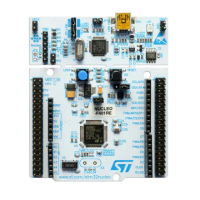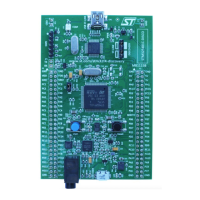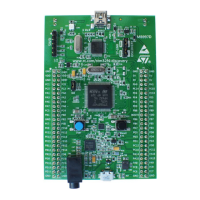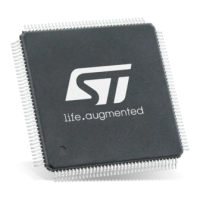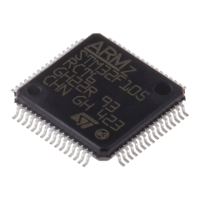RM0402 Rev 6 1109/1163
RM0402 USB on-the-go full-speed (OTG_FS)
1122
1. The application must stop writing data on the AHB for the IN endpoint to be disabled.
2. The application must set the endpoint in NAK mode.
– SNAK = 1 in OTG_DIEPCTLx
3. Wait for the INEPNE interrupt in OTG_DIEPINTx.
4. Set the following bits in the OTG_DIEPCTLx register for the endpoint that must be
disabled.
– EPDIS = 1 in OTG_DIEPCTLx
– SNAK = 1 in OTG_DIEPCTLx
5. Assertion of the EPDISD interrupt in OTG_DIEPINTx indicates that the core has
completely disabled the specified endpoint. Along with the assertion of the interrupt, the
core also clears the following bits:
– EPENA = 0 in OTG_DIEPCTLx
– EPDIS = 0 in OTG_DIEPCTLx
6. The application must read the OTG_DIEPTSIZx register for the periodic IN EP, to
calculate how much data on the endpoint were transmitted on the USB.
7. The application must flush the data in the endpoint transmit FIFO, by setting the
following fields in the OTG_GRSTCTL register:
– TXFNUM (in OTG_GRSTCTL) = Endpoint transmit FIFO number
– TXFFLSH in (OTG_GRSTCTL) = 1
The application must poll the OTG_GRSTCTL register, until the TXFFLSH bit is cleared by
the core, which indicates the end of flush operation. To transmit new data on this endpoint,
the application can re-enable the endpoint at a later point.
• Transfer Stop Programming for IN endpoints
The application must use the following programing sequence to stop any transfers (because
of an interrupt from the host, typically a reset).
Sequence of operations:
1. Disable the IN endpoint by setting:
– EPDIS = 1 in all N/A_DIEPCTLx registers
2. Wait for the EPDIS interrupt in N/A_DIEPINTx, which indicates that the IN endpoint is
completely disabled. When the EPDIS interrupt is asserted the following bits are
cleared:
– EPDIS = 0 in N/A_DIEPCTLx
– EPENA = 0 in N/A_DIEPCTLx
3. Flush the TxFIFO by programming the following bits:
– TXFFLSH = 1 in N/A_GRSTCTL
– TXFNUM = “FIFO number specific to endpoint” in N/A_GRSTCTL
4. The application can start polling till TXFFLSH in N/A_GRSTCTL is cleared. When this
bit is cleared, it ensures that there is no data left in the Tx FIFO.
• Generic non-periodic IN data transfers
Application requirements:
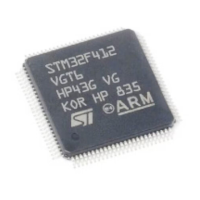
